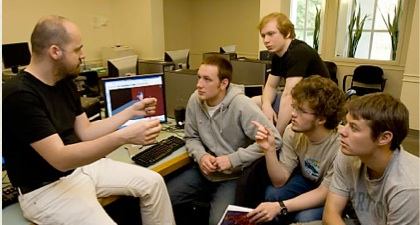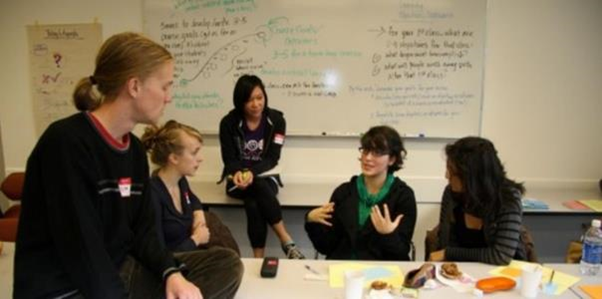14. Interaction
14.1. Types of Learner Interaction
There are three different ways learners can interact when studying (Moore, 1989), and each of these ways requires a somewhat different mix of media and technology.
Interaction with Learning MaterialsThis is the interaction generated when students work on a particular medium, such as a printed textbook, a learning management system, or a short video clip, without direct intervention from an instructor or other students. This interaction can be ‘reflective’, without any overt actions, or it can be ‘observable’, in the form of the assessed response, such as a multiple-choice test, or as notes to assist memory and comprehension.
Computer technology can greatly facilitate learners’ interaction with learning resources. Self-administered online tests can provide feedback to students on their comprehension or coverage of a subject area. Such tests can also provide feedback to teachers on topic areas where students are having difficulty, and can also be used for grading of students on their comprehension. Using standard test software built into learning management systems, students can be automatically assessed and graded on their comprehension of course materials. More advanced activities might include composing music using software that converts musical notation to audio, entering data to test concepts through online simulations, or participating in games or decision-making scenarios controlled by the computer. Thus computer-managed learner interaction is particularly good for developing comprehension and understanding of concepts and procedures, but it has limitations in developing the higher-order learning skills of analysis, synthesis and critical thinking, without additional human intervention of some kind.
There are other ways besides computer-managed learning to facilitate interaction between learners and learning material. Textbooks may include activities set by the author (as in this textbook), or instructors can set student activities around set readings. Other student activities might include reading text or watching videos embedded in a learning management system, conducting a structured approach to finding and analyzing web-based materials, or downloading and editing information from the web to create e-portfolios of work. These activities may or may not be assessed, although evidence suggests that students, and in particular students studying online, tend to focus more assessed activities.
In other words, with good design and adequate resources, technology-based instruction can provide high levels of student interaction with the learning materials. There are strong economic advantages in exploiting the possibilities of learners’ interaction with learning materials because intense student-interaction with learning resources increases the time students spend on learning (‘time-on-task’), which tends to lead to increased learning (see Means et al., 2010). Perhaps more importantly, such activity, when well designed, can reduce the time the teacher needs to spend on interacting with each student.
Interaction between Students and Teacher

Student-teacher interaction is often needed though in order to develop many of the higher-order learning outcomes, such as analysis, synthesis, and critical thinking. This is particularly important for developing academic learning, where students are challenged to question ideas and to acquire deep understanding. This often requires dialogue and conversation, either one-on-one between instructor and students or between an instructor and a group of students. The role of the teacher in for instance either face-to-face seminars or online collaborative learning is therefore critical.
Some technologies, such as online discussion forums, enable or encourage such dialogue or discourse between students and instructors at a distance. The main limitation of student-teacher interaction is that it can be time-demanding for the teacher, and therefore does not scale easily.
Student - Student Interaction
High-quality student-student interaction can be provided equally well both in face-to-face and online learning contexts. Asynchronous online discussion forums built into learning management systems can enable this kind of interaction. Connectivist MOOCs and communities of practice also enable student-student interaction.
Again though quality depends on good design. Merely putting students together in a group, whether online or face-to-face is not likely to lead to either high levels of participation or high quality learning without careful thought being given to the educational goals of discussion within a course, the topics for discussion and their relationship to assessment and learning outcomes, and without strong preparation of the students by the instructor for self-directed discussions.
In a technologically rich learning environment, then, a key decision for a teacher or course designer is choosing the best mix of these three different kinds of interaction, taking into consideration the epistemological approach, the amount of time available for both students and instructor, and the desired learning outcomes. Technology can enable all three kinds of interaction.
